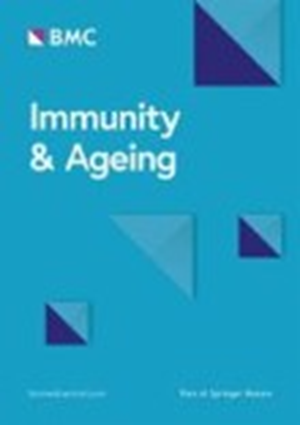The role of blood related inflammatory factors on age-related macular degeneration (AMD)
IF 5.6
2区 医学
Q1 GERIATRICS & GERONTOLOGY
引用次数: 0
Abstract
Age-related macular degeneration (AMD) is a significant retinal disease that leads to irreversible low vision, particularly in developing countries. The variation in AMD prevalence among different racial groups and highlighted role of inflammation on disease pathology from previous studies which yielded in inconsistent findings, It seems to be of great importance to do more investigation in this field. This case control study involved 204 participants, divided into four groups of equal size (51 individuals per group). Three groups represented AMD cases of varying severity according to Beckman classification (3 groups) and one healthy control group. Sampling was conducted exhaustively until the desired sample size was reached. The control group comprised healthy individuals without any infectious or inflammatory systemic, ophthalmic disease. Blood samples were collected to measure inflammatory factors, including lymphocytes, monocytes, neutrophils, neutrophil-to-lymphocyte ratio (NLR), and C-reactive protein (CRP). Collected data were analyzed by statistical methods in SPSS version 21. Of the participants, 51% were women, and their ages ranged from 47 to 89 years (62.2 ± 8). According to multiple logistic regression analysis, age exhibited a statistically significant positive association with AMD severity (P = 0.038, odds ratio [OR] = 1.034). ANOVA results indicated a significant association between neutrophil count and AMD severity (P < 0.001). As the disease severity increased, the number of neutrophils decreased. The mean ± SD neutrophil counts for early, intermediate and advanced AMD were 3849 ± 800, 3702 ± 734, and 3342 ± 823, respectively. No statistically significant associations were found between lymphocyte count, monocyte count, neutrophil-to-lymphocyte ratio, CRP, and AMD. There was a significant relationship between the number of neutrophils in peripheral blood and the severity of AMD in study participants which needs more evaluation for the potential utility of this factor in the prognosis of AMD. There was not any significant relationship among the other factors and AMD.血液相关炎症因子对老年性黄斑变性(AMD)的作用
老年性黄斑变性(AMD)是一种严重的视网膜疾病,会导致不可逆的低视力,尤其是在发展中国家。由于不同种族群体的老年黄斑变性发病率存在差异,而且以往的研究强调炎症对疾病病理的作用,但得出的结论并不一致,因此在这一领域开展更多的调查似乎非常重要。这项病例对照研究涉及 204 名参与者,分为四组,每组 51 人,每组人数相等。根据贝克曼分类法,三组代表不同严重程度的 AMD 病例(3 组),另一组为健康对照组。抽样工作一直持续到达到所需的样本量为止。对照组由没有任何感染性或炎症性系统性眼科疾病的健康人组成。采集的血液样本用于测量炎症因子,包括淋巴细胞、单核细胞、中性粒细胞、中性粒细胞与淋巴细胞比值(NLR)和 C 反应蛋白(CRP)。收集的数据采用 SPSS 21 版的统计方法进行分析。在参与者中,51%为女性,年龄在47至89岁之间(62.2 ± 8)。根据多元逻辑回归分析,年龄与 AMD 严重程度呈显著正相关(P = 0.038,几率比 [OR] = 1.034)。方差分析结果表明,中性粒细胞计数与 AMD 严重程度有明显的相关性(P < 0.001)。随着疾病严重程度的增加,中性粒细胞的数量也随之减少。早期、中期和晚期AMD中性粒细胞计数的平均值(±SD)分别为3849±800、3702±734和3342±823。淋巴细胞计数、单核细胞计数、中性粒细胞与淋巴细胞比率、CRP与AMD之间没有统计学意义上的关联。研究参与者外周血中的中性粒细胞数量与老年性黄斑病变的严重程度有明显关系,需要进一步评估这一因素在老年性黄斑病变预后中的潜在作用。其他因素与老年性黄斑病变之间没有明显关系。
本文章由计算机程序翻译,如有差异,请以英文原文为准。
求助全文
约1分钟内获得全文
求助全文
来源期刊

Immunity & Ageing
GERIATRICS & GERONTOLOGY-IMMUNOLOGY
CiteScore
10.20
自引率
3.80%
发文量
55
期刊介绍:
Immunity & Ageing is a specialist open access journal that was first published in 2004. The journal focuses on the impact of ageing on immune systems, the influence of aged immune systems on organismal well-being and longevity, age-associated diseases with immune etiology, and potential immune interventions to increase health span. All articles published in Immunity & Ageing are indexed in the following databases: Biological Abstracts, BIOSIS, CAS, Citebase, DOAJ, Embase, Google Scholar, Journal Citation Reports/Science Edition, OAIster, PubMed, PubMed Central, Science Citation Index Expanded, SCImago, Scopus, SOCOLAR, and Zetoc.
 求助内容:
求助内容: 应助结果提醒方式:
应助结果提醒方式:


